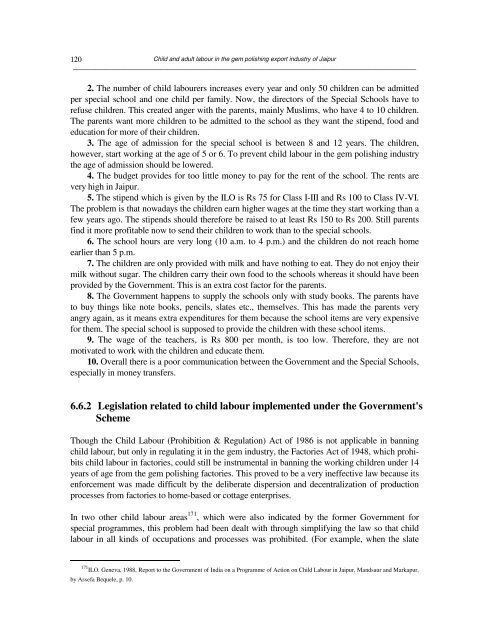Create successful ePaper yourself
Turn your PDF publications into a flip-book with our unique Google optimized e-Paper software.
120<br />
<strong>Child</strong> <strong>and</strong> <strong>adult</strong> <strong>labour</strong> <strong>in</strong> <strong>the</strong> <strong>gem</strong> polish<strong>in</strong>g <strong>export</strong> <strong>in</strong>dustry <strong>of</strong> Jaipur<br />
──────────────────────────────────────────────────────────────────────────────────────────────<br />
2. The number <strong>of</strong> child <strong>labour</strong>ers <strong>in</strong>creases every year <strong>and</strong> only 50 children can be admitted<br />
per special school <strong>and</strong> one child per family. Now, <strong>the</strong> directors <strong>of</strong> <strong>the</strong> Special Schools have to<br />
refuse children. This created anger with <strong>the</strong> parents, ma<strong>in</strong>ly Muslims, who have 4 to 10 children.<br />
The parents want more children to be admitted to <strong>the</strong> school as <strong>the</strong>y want <strong>the</strong> stipend, food <strong>and</strong><br />
education for more <strong>of</strong> <strong>the</strong>ir children.<br />
3. The age <strong>of</strong> admission for <strong>the</strong> special school is between 8 <strong>and</strong> 12 years. The children,<br />
however, start work<strong>in</strong>g at <strong>the</strong> age <strong>of</strong> 5 or 6. To prevent child <strong>labour</strong> <strong>in</strong> <strong>the</strong> <strong>gem</strong> polish<strong>in</strong>g <strong>in</strong>dustry<br />
<strong>the</strong> age <strong>of</strong> admission should be lowered.<br />
4. The budget provides for too little money to pay for <strong>the</strong> rent <strong>of</strong> <strong>the</strong> school. The rents are<br />
very high <strong>in</strong> Jaipur.<br />
5. The stipend which is given by <strong>the</strong> ILO is Rs 75 for Class I-III <strong>and</strong> Rs 100 to Class IV-VI.<br />
The problem is that nowadays <strong>the</strong> children earn higher wages at <strong>the</strong> time <strong>the</strong>y start work<strong>in</strong>g than a<br />
few years ago. The stipends should <strong>the</strong>refore be raised to at least Rs 150 to Rs 200. Still parents<br />
f<strong>in</strong>d it more pr<strong>of</strong>itable now to send <strong>the</strong>ir children to work than to <strong>the</strong> special schools.<br />
6. The school hours are very long (10 a.m. to 4 p.m.) <strong>and</strong> <strong>the</strong> children do not reach home<br />
earlier than 5 p.m.<br />
7. The children are only provided with milk <strong>and</strong> have noth<strong>in</strong>g to eat. They do not enjoy <strong>the</strong>ir<br />
milk without sugar. The children carry <strong>the</strong>ir own food to <strong>the</strong> schools whereas it should have been<br />
provided by <strong>the</strong> Government. This is an extra cost factor for <strong>the</strong> parents.<br />
8. The Government happens to supply <strong>the</strong> schools only with study books. The parents have<br />
to buy th<strong>in</strong>gs like note books, pencils, slates etc., <strong>the</strong>mselves. This has made <strong>the</strong> parents very<br />
angry aga<strong>in</strong>, as it means extra expenditures for <strong>the</strong>m because <strong>the</strong> school items are very expensive<br />
for <strong>the</strong>m. The special school is supposed to provide <strong>the</strong> children with <strong>the</strong>se school items.<br />
9. The wage <strong>of</strong> <strong>the</strong> teachers, is Rs 800 per month, is too low. Therefore, <strong>the</strong>y are not<br />
motivated to work with <strong>the</strong> children <strong>and</strong> educate <strong>the</strong>m.<br />
10. Overall <strong>the</strong>re is a poor communication between <strong>the</strong> Government <strong>and</strong> <strong>the</strong> Special Schools,<br />
especially <strong>in</strong> money transfers.<br />
6.6.2 Legislation related to child <strong>labour</strong> implemented under <strong>the</strong> Government's<br />
Scheme<br />
Though <strong>the</strong> <strong>Child</strong> Labour (Prohibition & Regulation) Act <strong>of</strong> 1986 is not applicable <strong>in</strong> bann<strong>in</strong>g<br />
child <strong>labour</strong>, but only <strong>in</strong> regulat<strong>in</strong>g it <strong>in</strong> <strong>the</strong> <strong>gem</strong> <strong>in</strong>dustry, <strong>the</strong> Factories Act <strong>of</strong> 1948, which prohibits<br />
child <strong>labour</strong> <strong>in</strong> factories, could still be <strong>in</strong>strumental <strong>in</strong> bann<strong>in</strong>g <strong>the</strong> work<strong>in</strong>g children under 14<br />
years <strong>of</strong> age from <strong>the</strong> <strong>gem</strong> polish<strong>in</strong>g factories. This proved to be a very <strong>in</strong>effective law because its<br />
enforcement was made difficult by <strong>the</strong> deliberate dispersion <strong>and</strong> decentralization <strong>of</strong> production<br />
processes from factories to home-based or cottage enterprises.<br />
In two o<strong>the</strong>r child <strong>labour</strong> areas 171 , which were also <strong>in</strong>dicated by <strong>the</strong> former Government for<br />
special programmes, this problem had been dealt with through simplify<strong>in</strong>g <strong>the</strong> law so that child<br />
<strong>labour</strong> <strong>in</strong> all k<strong>in</strong>ds <strong>of</strong> occupations <strong>and</strong> processes was prohibited. (For example, when <strong>the</strong> slate<br />
171 ILO, Geneva, 1988, Report to <strong>the</strong> Government <strong>of</strong> <strong>India</strong> on a Programme <strong>of</strong> Action on <strong>Child</strong> Labour <strong>in</strong> Jaipur, M<strong>and</strong>saur <strong>and</strong> Markapur,<br />
by Assefa Bequele, p. 10.


















